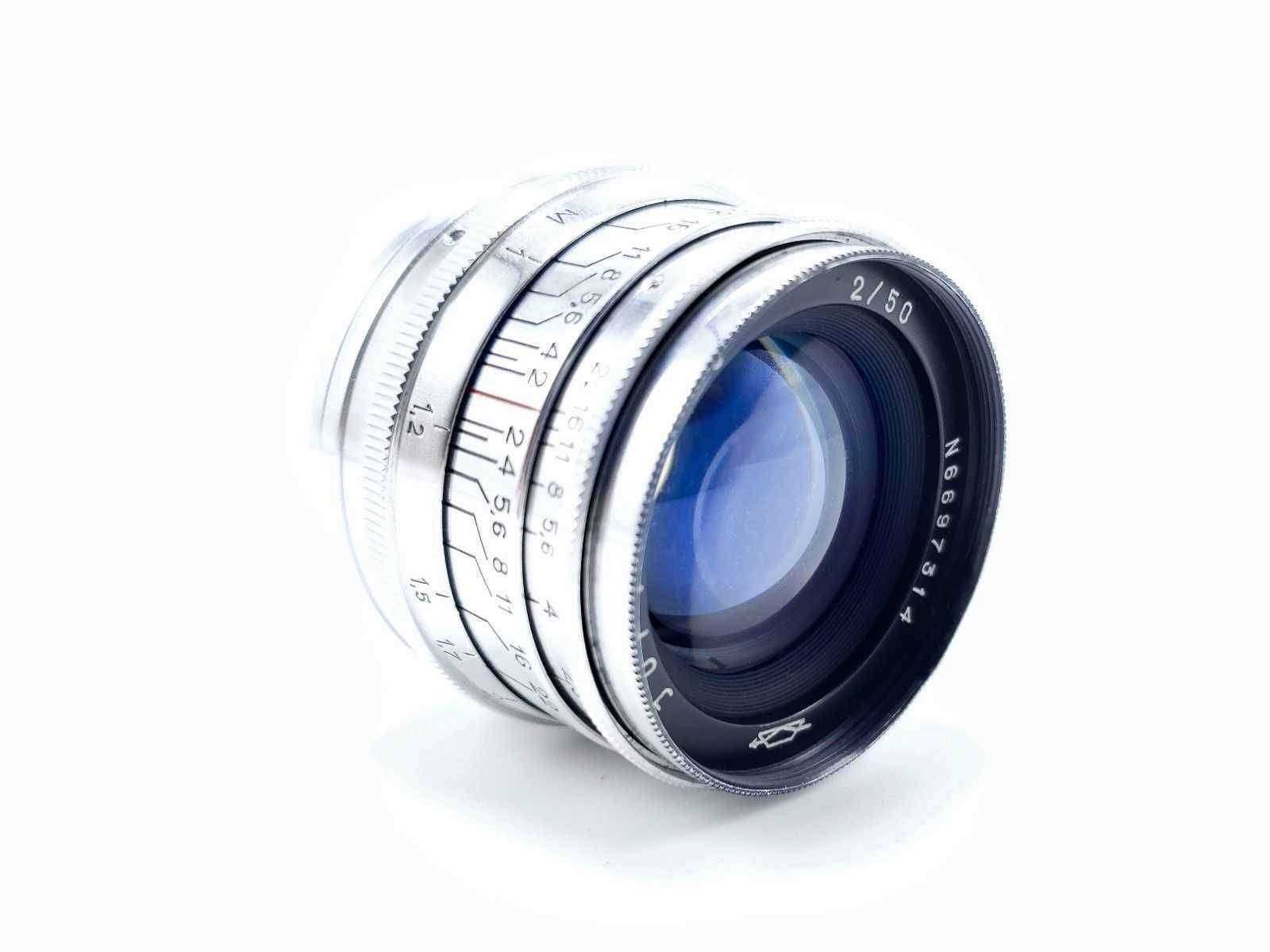This article contains affiliate links, for more information see the disclosure here. Using these links won't cost you a thing, may save you money, and it helps us to keep putting out great material for you to read while remaining ad free. Thanks for your support!
About
Lens model: Jupiter-8 50mm f/2
At a glance: Well recognized for its remarkably compact size and excellent sharpness, this lens delivers beautifully unique images with a quality well suited for portraiture and street photography.
Our score: 4/5
Where to buy
Note: We purchased the Jupiter-8 50mm f/2 used in this review with our own money. This review is independent and is not sponsored by the lens manufacturer or endorsed by them in any way.
Want to say thanks for an ad-free, subscription free experience and top-notch content?
 Buy me a coffee
Buy me a coffee
The backstory
Well recognized for its remarkably compact size and excellent sharpness, this lens delivers beautifully unique images with a quality well suited for portraiture and street photography.
While this lens is often referred to as a “copy” or “clone” of the Zeiss Sonnar 50mm f/2, if you read through the history books, you’ll find that it isn’t really a “copy” or “clone” so much as it is essentially a renegade Sonnar produced by Russian appropriated German factory equipment and technology that was moved back to the Russian homeland, then re-keyed and re-died to produce the Jupiter brand. When the Soviets took East Germany at the end of World War II, they captured much of the tech that they came across in their zone, including the machinery and blueprints used to make some of the best German lenses.
Jupiter-8 f2 50mm Prime Lens Overview
- Extremely compact
- Incredibly light weight
- An unprecedented value
- Excellent sharpness, colors and contrast
- Low barrel distortion
- Low lateral chromatic aberration
- Reasonably fast and bright f/2 maximum aperture allows for shallow depth of field and for good results in low-light photography
- Quite sharp at center wide open at f/2 and sharpest across the frame by f/5.6
- Good image compression for a pleasing bokeh effect
- Ideal for portraits, street photography, and close ups
Jupiter-8 f2 50mm Prime Lens Sample Images


Image Quality
Given this lineage, it’s no surprise that the Jupiter-8 delivers excellent results, especially in the center of the frame. Wide open at f/2, the lens offers a pleasingly soft glow that’s perfect for portraits, creating a dreamy, almost ethereal look. The sharpness in the center is commendable, though there’s a noticeable fall-off towards the edges, which can be a desirable effect depending on your style.
Colors are rendered with a subtle warmth, giving your images a slightly vintage feel that’s perfect for capturing the atmosphere of a scene. Contrast is moderate, which works well for black-and-white photography—a genre where the Jupiter-8 particularly excels. The single-coating on the optics does an adequate job of controlling flare, though you might still encounter some ghosting in high-contrast situations. Overall, the Jupiter-8 delivers a unique and charming image quality that stands out in today’s digital age.
Sharpness
The bokeh produced by the Jupiter-8 50mm f/2 is one of its most celebrated features. Thanks to its 9-blade aperture, the out-of-focus areas are rendered smoothly, with highlights appearing as soft, rounded orbs. The bokeh has a gentle, almost painterly quality that adds depth and dimension to your images, particularly when shooting wide open. Whether you’re photographing a portrait, a still life, or an urban scene, the Jupiter-8’s bokeh helps to create a visually appealing separation between your subject and the background.
Build Quality
The build quality of the Jupiter-8 is exactly what you’d expect from a lens that has survived decades of use and abuse. The all-metal construction gives it a durability that’s hard to find in today’s plastic-heavy lenses. The focus ring is smooth, with just the right amount of resistance to allow for precise adjustments. The aperture ring, though not de-clickable, offers firm, positive stops that make it easy to set your desired f-stop without taking your eye off the viewfinder.
However, it’s important to note that the Jupiter-8 lacks modern conveniences like weather sealing or a lens hood, so you’ll need to be careful when using it in challenging conditions. Given its age, it’s also not uncommon to find copies with slight variations in performance due to the lens’s history and how well it’s been maintained.
Manual Focus Performance
Manual focusing with the Jupiter-8 is a delightful experience, particularly for those who enjoy the tactile feedback of vintage lenses. The focus throw is long, allowing for precise control over your focus point—crucial when working with the shallow depth of field at f/2. The smoothness of the focus ring makes it easy to achieve critical focus, whether you’re shooting portraits, landscapes, or street photography.
The lens is most commonly found with the M39 mount, making it a popular choice for rangefinder cameras, though it can easily be adapted to modern mirrorless systems with the appropriate adapter. If you’re new to manual focusing, the Jupiter-8 is a great lens to learn with, as its smooth operation and forgiving character make it a pleasure to use.
Feature Breakdown
The Jupiter-8 is a no-frills lens, but that’s part of its charm. It’s fully manual, with no autofocus, no image stabilization, and no electronic connections. But what it does offer is a straightforward, reliable design that’s easy to use and produces beautiful results. The single-coating on the optics helps to reduce flare and ghosting, though it’s not as effective as modern multi-coatings. The lens’s compact size and light weight make it an excellent choice for street photographers or anyone who values portability.
The lens’s M39 mount is another point of interest, as it’s compatible with a wide range of rangefinder cameras and can be adapted to many modern mirrorless systems. This versatility makes the Jupiter-8 a great addition to any photographer’s kit, especially for those who enjoy experimenting with vintage lenses.
Optical Construction
The optical design of the Jupiter-8 is based on the classic Zeiss Sonnar formula, with 6 elements in 3 groups. This design is known for its ability to produce sharp images with a pleasing out-of-focus background, making it a favorite among portrait photographers. The lens’s simplicity is part of what makes it so enduring—there’s nothing extraneous here, just quality optics that have stood the test of time.
While the single-coating on the elements is not as advanced as modern multi-coatings, it still does a decent job of reducing reflections and improving contrast. The lens is also relatively compact, thanks to its simple optical design, making it easy to carry around for day-to-day shooting.
What Could Be Better
As much as I admire the Jupiter-8, it’s not without its quirks. The single-coated optics mean that flare and ghosting can be an issue, particularly when shooting in bright, direct light. The lens also suffers from some chromatic aberration, especially in high-contrast scenes, which might require correction in post-processing.
Another potential downside is the lens’s minimum focusing distance of 1 meter, which can be limiting if you’re used to getting up close and personal with your subjects. And, of course, the manual focus operation means it’s not the best choice for fast-moving subjects or action photography.
Lastly, due to its age and the variations in manufacturing quality during the Soviet era, the performance of individual Jupiter-8 lenses can vary. It’s worth testing out a few copies if you have the opportunity to find one that performs well.
Conclusion
The Jupiter-8 50mm f/2 is a lens that has earned its place in the pantheon of classic optics. It’s not perfect, but its imperfections are part of what makes it so endearing. This lens offers a unique combination of vintage character and optical performance that’s hard to find in modern glass. Priced between $50 and $100 on the second-hand market, it’s an affordable way to add a bit of history and personality to your photography.
Whether you’re a seasoned photographer looking to experiment with vintage lenses or a newcomer curious about the charm of Soviet-era optics, the Jupiter
Technical Specifications
| Focal Length (35mm format): | 50mm |
| Maximum Aperture: | f/2 |
| Minimum Aperture: | f/22 |
| Mount format: | Leica M-39 Screw Mount |
| Format: | 35mm Film |
| Angle of View (35mm format): | 45° |
| Focusing Distance: | 1m to Inifinity |
| Elements/Groups: | 6 elements in 3 groups |
| Number of Blades: | 9 (rounded) |
| Focus type: | Manual Focus (MF) |
| Filter size: | 40.5mm |
| Manufacturer: | Jupiter |
| Country of Manufacture: | USSR (Russia) |
| Weight: | 130g |
Features
| Feature | Details |
|---|---|
| Focus ring | Manual |
| Autofocus | No |
| Image stabilization | No |
| Optical coating(s) | Yes - Single-coated |
| Front element rotation | Yes |
| Internal focusing | No |
| Lens extension while focusing | Yes |
| Focus hold/lock button | No |
| Physical aperture ring | Yes |
| De-clickable aperture | No |
| Architecture | Rangefinder |
Image quality: Excellent
Bokeh: Excellent
Build quality: Superb
Micro contrast: Excellent
Ergonomics: Flawless
Center sharpness (wide open): Excellent
Edge sharpness (wide open): Very good
| Pros | Cons |
| Light and easy to carry | Manual focus may present a challenge to first time users |
| Premium build quality | |
| Excellent optical quality overall | |
| Sharp at center wide open | |
| Renders beautiful classic colors |
Equipment
The sample images in this post were captured using a Sony A7r, Mark III
The product images were captured using a Samsung Galaxy Note 9








